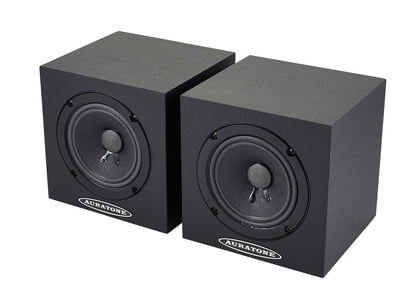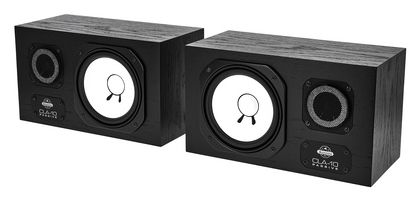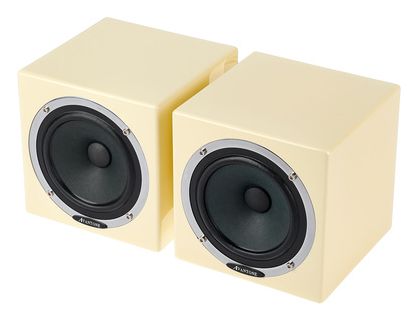Today we bring you some of the Best Passive Studio Monitors Available in 2024. As most of you may know, monitors are of the utmost importance when it comes to having a professional studio setup. They’re not only a set of speakers for listening to different tracks but also help sound engineers pinpoint how to improve a mix in terms of errors and frequency-based adjustments.
However, picking a set of monitors for your studio is no walk in the park. Remember, a sound engineer is only as good as his equipment. Therefore, when making this difficult decision, different aspects must be considered depending on the size of your studio, your level of expertise and your overall goal.
Firstly, studio monitors can be broadly divided into two categories: Active and Passive. Active monitors are self-sufficient in that they can generate their own power. On the other hand, passive speakers lack the technology for power generation and need to be paired with an amplifier to drive them.
Secondly, another aspect to consider is the setup size and the sound engineer’s preference. You may choose to have near-field, mid-field or far-field monitoring. Smaller setups require near-field speakers that give the best results when placed closer to the listener. Similarly, the other two sizes may be chosen if a larger setup is involved.
Best Passive Studio Monitors Available 2024
1. ATC SCM12 Pro (Pair)
ATC has been dishing out high-end speaker systems since 1974.
The SCM12 Pro is one of the most affordable and compact offerings from the ATC company. The monitors were released back in 2016 and offer two-way monitoring capabilities. Being passive speakers, driving them through a powerful amp will bring the monitors’ impressive sound characteristics to the fore.
ATC have also introduced their dual mono amplifier called the P1 Pro alongside the SCM Pros to give sound engineers a one-stop solution for their home and professional studio setups. As these units complement each other very well, the amp and monitors can be purchased separately or in a value-added bundle.
Key Features:
- At first glance
The individual monitors measure 15.7” x 9.4” x 9.3” and weigh almost 11 kg each. Both speakers have a couple of binding post inputs and outputs. The single unit is designed to have a 6-inch woofer and a 1-inch tweeter combination confined in a sealed enclosure. The guild quality looks solid, and the external chassis gives a premium feel.
- Technicalities
Both studio monitors are equipped with what ATC calls Constrained Layer Damping (CLD). Each woofer has a composite cone made of multiple layers with a damping mechanism in its center to silence any unwanted artifacts.
The 6” woofer’s frequency response goes down to 80 Hz at the – 2 dB point with a cut-off range between 56Hz – 22kHz at -6 dB. The recommended watts per channel range from 75W – 300W for this two-way monitoring system.
- Character & Sound
The SCM12 Pro monitors give out great clarity in the mid ranges. The woofer mechanism is enclosed in a sealed casing, so the low-end frequencies sound tight and punchy. Owing to its CLD technology, the monitors maintain their clarity no matter how hard an amplifier may be driving them.
The 1-inch tweeter has an impressive range of motion and brightens up those high-level frequencies while maintaining impressive clarity.
Rated from 75W – 300W, the SCM Pros give a cleaner headroom when driven by more power. Compared to their size, the monitors can push out a decent volume equal to 108 dB at a 1-meter range.
Pros:
The SCM12 Pro Monitors are deceptively small for the quality of sound and volume they can deliver. Capable of delivering an exceptional response along all frequency levels, the speakers can be a good addition to any small to medium-sized studio. The bass, in particular, sounds warm and profound, while the CLD design keeps rumbling and noise in check.
Cons:
Although billed as the most affordable monitors from the ATC line, the SCM12 Pros are priced toward the expensive side. Since these are passive monitors, a high-end amplifier will be required to get the most out of them. In addition, the speakers tend to tilt a little more towards the bass frequencies.
Choose If:
The SCM12 Pro Monitors are nicely sized to sit on top of your workstation without taking up too much space. Feel free to choose these near-field studio monitors if you have a smaller setup, as they have just the right amount of juice to give you an exceptionally immersive experience.
If you like a slight bass boost and good clarity in the mid and high-end, the SCM12s will surely impress you.
2. Auratone 5C Super Sound
The Auratone 5C Monitors have been around since the 1960s.
Throughout the years, the appearance of the monitors may have changed slightly, but the technology inside has remained the same. Used by Quincy Jones while mixing the world-famous Thriller album by Michael Jackson, the monitors hold their own when it comes to delivering high-quality sound that is uncolored and accurate.
Strangely, there was a time when the 5Cs were discontinued and could only be found online on the secondhand market. Thankfully, the monitors have made a comeback and successfully replicate the features of their most sought-after version from the 1980s, much to the delight of sound engineers worldwide
Key Features:
- First Impression
Each pair of the 5C monitors is designed in a 6.5” x 6.5” x 6” sealed cabinet that houses a single 4.5” driver. The driver has a paper cone designed to eliminate comb filtering issues. The speakers are compact, lightweight and hardly take up any space on a workstation. They come in black and wood grain mahogany finishes.
- Amplifier
The recommended amplifier to drive the 5C monitors is Auratone’s own A2-30 amp which was awarded the Technical Excellence & Creativity Award by NAMM in 2020. The amp can be purchased separately or as a bundle in combination with the 5C monitors.
In addition, an active version of the 5C monitors is also available, with an integrated amp that uses the same technology as the A2-30.
- Character & Sound
The Auratone 5Cs have been known to be extremely accurate as they honestly showcase uncolored and unchanged sound in terms of tonal characteristics. So, it’s no surprise that the great Quincy Jones calls them the “Truth Speakers”.
The monitors spare no details and become a handy tool in assisting the sound engineer in making decisions pertaining to which frequencies need to be cut or boosted. Different monitors react to the top and bottom end frequencies differently, so dealing with the mid-range can be a useful factor in deciding which offering has an edge over the other.
The 5Cs particularly focus on the mids while giving significant clarity in the upper and lower range. Also, coming in a pair, the 5Cs have impressive stereo imaging and accurately reveal a presence or lack of panning.
Pros:
Judging by its compact size and considerably lower price tag, the 5Cs pack quite a punch and perform beyond expectations. You’ll get great clarity among all frequency ranges with a high level of detail in the mid-range. In addition, the accuracy provided by the monitors will ensure that your mix sounds equally good on other sound systems.
Cons:
Due to their diminutive size, driving them with a more powerful amp may add some distortion to your mix if it is packed with too much bass. The 5Cs are near-field monitors and are somewhat limited in terms of their volume. The stick-on base pads that come with the 5Cs seem low-quality and cheap.
Choose If:
Because of their slightly lower volume, the monitors are suitable for extended use in a near-field setting as there will be no ear fatigue issues. In addition, if you’re looking for detail in the middle frequencies and an accurate depiction of the mix as it was meant to be heard, be sure to give these a try. Also, any time-based effects applied to the mix will sound particularly good on the 5Cs.
3. Avantone CLA-10 (Pair)
Dubbed the “white cone in the black box”, Avantone CLA-10s are a popular choice among many sound engineers.
The CLA-10s are a product of the collaboration between Avantone and Chris Lord Alge, a renowned sound engineering expert famous for mixing multiple mainstream albums.
Chris has done several projects with artists like Tina Turner, Rob Zombie, Bruce Springsteen, the Rolling Stones, Green Day, and many more, so you know if Chris puts his seal of approval on something, it must be good.
Back when Yamaha’s NS10Ms got discontinued in early 2000, Avantone stepped up its game and came up with the modern representation of the old NS10Ms by delivering the CLA-10s. The Avantone monitors have had minor upgrades over the years in terms of design and appearance and are now available in more modern-looking packaging.
Key Features:
- Appearance
The Avantone CLA-10s weigh around 6 kgs and measure 7.75” x 15” x 8.5”. The closed box design includes 2 binding port inputs on the back. The front of the monitor boasts a 7” woofer and a 1.3” tweeter.
This time, the cone is a single piece, while on the NS10s, the design was a bit different and had two parts joined together. The cabinet is made of wood, and the back panel doesn’t come off compared to the older versions.
- Technicalities
The people at Avantone have done their homework and succeed in replicating the same tonal characteristics previously observed in the NS10Ms. The company has meticulously recreated all components using the same materials used in the construction of the original units, if not better, so there is no compromise on quality.
The CLA-10s can be driven by any 60W – 120W power range amp. The monitors offer a loudness of 90dB at a 1-meter range and have a frequency response of 60Hz – 20kHz.
- Characteristics and Sound
The sound delivery on the CLA-10s is very close to that on the NS10s of the past. As most monitors tend to focus more on the mid frequencies, the CLAs are no different. The mid-range is crystal clear and brings out the vocals in a mix nicely.
Having profound vocals in the center then helps to set the levels of everything around them to make the mix sound balanced. Having said that, the bass response on these monitors is almost negligible.
Pros:
The Avantone CLA-10s provide great mid-tone clarity and detail. The horizontal orientation with tweeters on the outer edges provides a vivid stereo experience. The CLAs are ideal for near-field monitoring and provide a decent level of loudness for small to medium-level studio setups.
Cons:
The bass on the CLA-10s is negligible. You may go back and forth between them and your high-end speakers to fix the bottom and treble frequencies, which can be a hassle for those looking for a complete solution setup. One obvious disadvantage of passive speakers is the added expense of an amp to drive them.
Choose If:
Choose the CLA-10s if you prefer a high level of clarity in the mid-range. The monitors can be a great tool in your mixing arsenal as getting the mid-ranges in your mix just right ensures that they will sound good on any other sound/speaker system. You can then move to your more high-end speakers and fix the highs and the lows.
4. Avantone MixCubes (Pair)
Avantone ventures into the world of cube speakers by releasing its own version, the MixCube.
The MixCube has a few different variants. They can be purchased as a pair or as a single unit depending on the requirement of your studio. Also, if you have an amp to drive the monitors, you can purchase the passive version or buy the active variant, which is self-sufficient in terms of power generation.
The MixCubes come in various colors, including Black, Red and Retro Cream. Unfortunately, as attractive as they may seem, the cubes have a love-hate relationship with most sound engineers. Some speak against them due to their limited response in recreating the highs and lows in a mix, while others praise them for their well-defined mids.
Key Features:
- Appearance
Contrary to how small these cube speakers look on some online stores, they’re a little bulky. Sized at 6.5” x 6.5” x 6.5”, a single MixCube weighs 3.2 kg. Each speaker has a pair of metal binding ports on the back. The mini monitors have a closed cabinet design which holds a 5.25” driver in the center of the front panel. The base of the cabinet has a quarter-inch pad for acoustic isolation.
- Technicalities
Avantone makes use of New Zealand pulp combined with mica fibers in the construction of the paper-based cone on their drivers. The materials used to construct the cone ensure rigidity and reduce its weight.
The monitors can be powered by a 50W – 200W solid-state amp or a 10W – 100W tube amp. The MixCubes push out a decent loudness level and have a volume of 93dB in the 1-meter range.
- Character & Sound
Avantone’s MixCubes thrive in the middle range. Considering their smaller size, you hear clarity in the lower-mid, mid, and high-mid levels. In addition, having this kind of isolation of the middle frequencies makes your vocals and stringed instruments pop out.
However, the MixCubes lack depth in the bass range and brilliance in the treble frequencies.
Considering as most of the music is being heard on headphones, laptops, or smartphones these days, which lack the lows and highs anyway, another advantage of mid-range isolation is that whatever sounds good on the cubes will sound good elsewhere too.
Pros:
The MixCubes brutally expose the flaws in your mix. Also, if you need a good reference or guide about the levels of different tracks in your mix, the cubes will get you there in a hurry.
These near-field monitors look aesthetically pleasing and don’t take up much space on your desktop.
Cons:
MixCubes are not recommended as stand-alone monitors for your studio setup. While they shine in the mids, they lack a suitable bass and treble response. For this reason, you’ll be going back and forth between the cubes and other speaker systems to work out instruments that appear in these ranges, such as bass guitars and drums cymbals.
Choose If:
If your setup includes full spectrum monitors, then you can use the MixCubes as a second line of defense against the irregularities in your mix. In addition, the cubes will isolate the mid ranges so that you can make the necessary adjustments in your mix to sound good on low-end speakers like the ones found on portable devices or car stereos, for instance.
Conclusion
After going through today’s post, you have become familiar with some of the top passive monitoring systems and their different shapes, sizes and capabilities. By and large, all the brands on the list have a similar agenda and target audience. You now know you’ll need to invest in an amplifier to drive these passive monitors.
Furthermore, most of these speakers deliver a profound mid-range but lack adequate treble and bass response. Pairing them with full spectrum speakers could be a good strategy since your main speakers can cover the deficiencies of these mid-dominant passive monitors. At the end of the day, it’s all a matter of preference.

Sultan Zafar is a guitar player from Islamabad, Pakistan. He has been playing music with various mainstream musicians for over 20 years. He is a song writer and music producer. These days he spends his time exploring different music genres and collaborating with fellow musicians on various projects. Read more..





